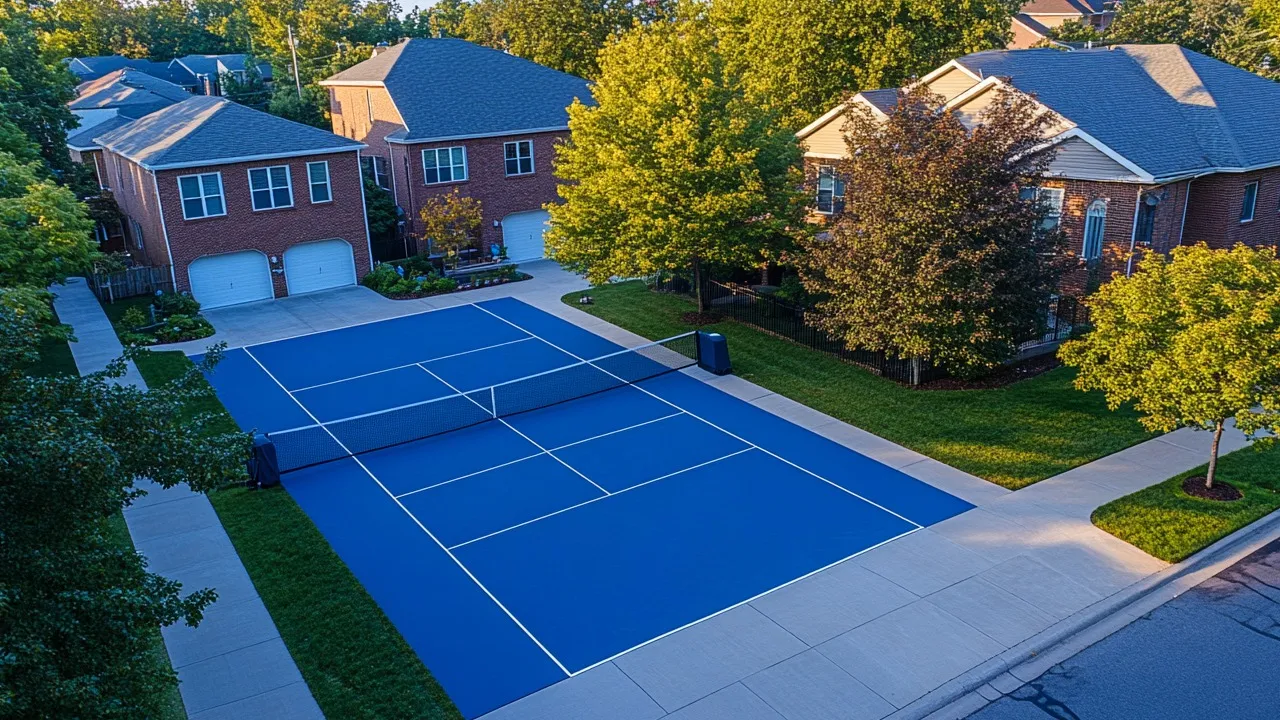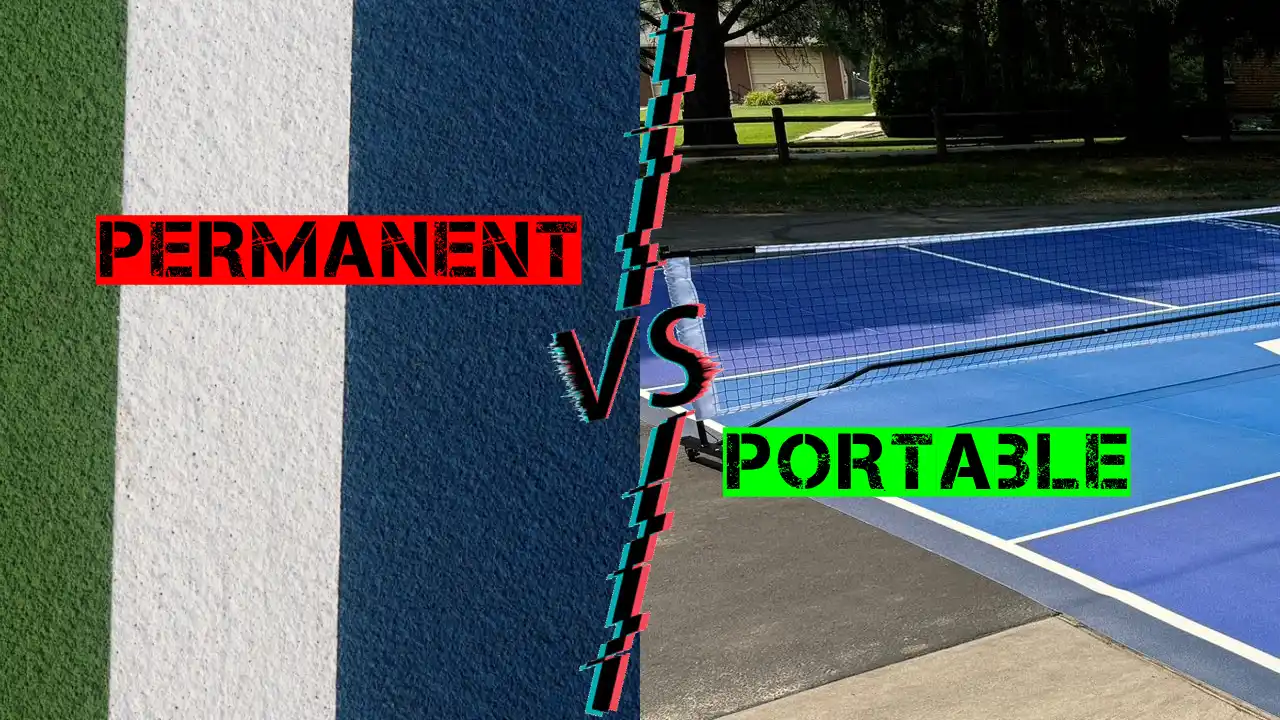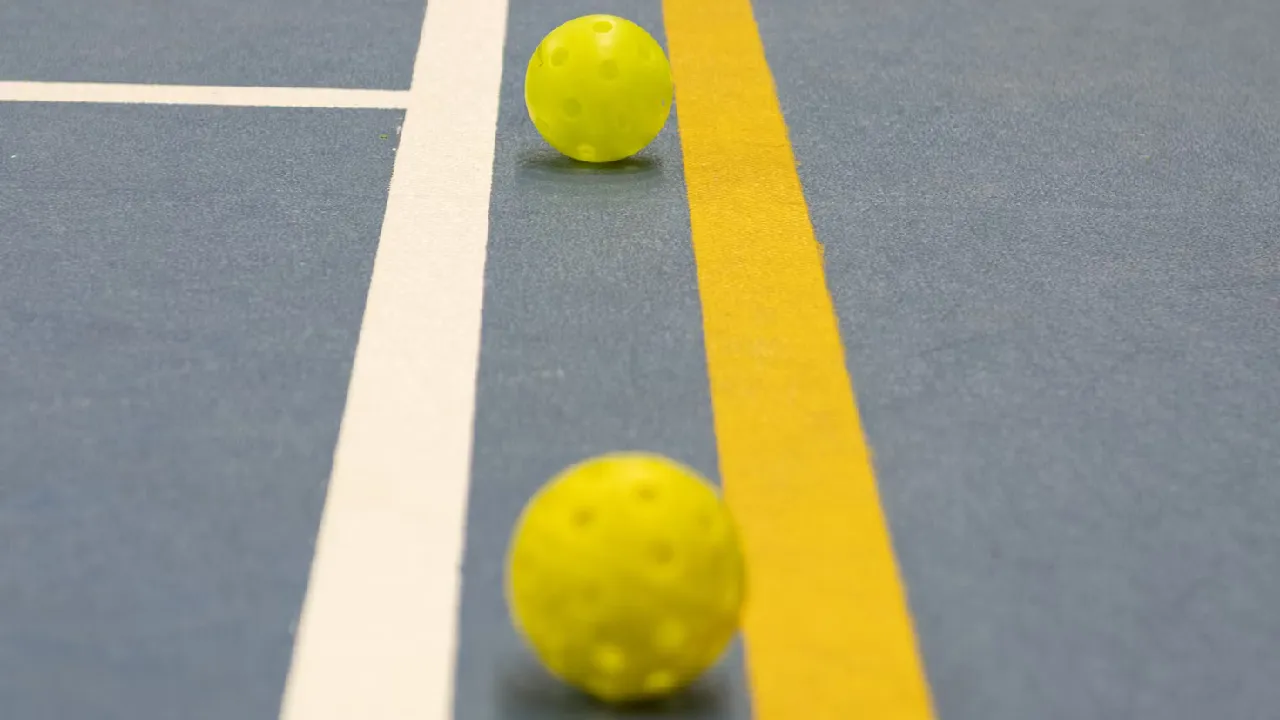Experience top-tier gameplay with our professional-grade basketball courts designed for optimal performance.
Learn moreUV protective, weather-resistant, built-in shock-absorbing layers, two-floor lining as per professional design ensuring no wear & tear - our Pickleball courts have it all!
Learn moreConstructed with impact-resistant surfaces for superior bounce and stability, our Spike Ball Courts ensure optimal player agility and comfort for thrilling matches!
Learn moreCrafted with UV-resistant advanced polymer surfaces for optimal traction and energy return technology for superior player comfort, ensuring peak performance in every game! Shop PortaCourts’ product of the week now at an unbeatable price.
Specifically engineered for professionals, PortaCourts presents Pickleball Court Pro for pro-players. Take your pickleball experience to the next level with our Pickleball Court Pro surface – built for unmatched grip, durability, and pro-level bounce. Designed for players who demand performance similar to top-tier tournaments like the PPA Tour, this surface offers the ultimate combination of comfort, stability, and safety.Whether you’re building a community court, upgrading a private space, or setting up for events, Pickleball Court Pro delivers a premium playing experience indoors or outdoors.Key FeaturesProfessional-Grade Surface: Made from durable acrylic roll mats with nano-granule texture for superior grip and wear resistance.Multi-Surface Compatibility: Installs over concrete, asphalt, wood, or any flat base.Flexible Installation: Temporary: Use single or double-sided tape. Permanent: Use glue for a long-lasting setup.Player-Safe Design: Special HIMOP coating offers high grip while protecting knees and joints during intense play.All-Weather Ready: Perfect for both indoor and outdoor courts – rain or shine.SpecificationsMaterial Thickness: 3.0 mmCore Layers: 2mm PVC + Fiberglass underlaymentTop Coat: Soft acrylic with HIMOP coating for grip and bounceWarranty: 3 YearsColor Options: Grey, Light Blue, Dark Blue, Green – or customize to match your brandWeight: Each roll approx. 270 lbs – easy to transport and installCourt Sizes AvailableCourt Pro Max: 24 ft × 50 ftCourt Pro Tour: 30 ft × 60 ftCourt Pro Tour Max: 36 ft × 60 ftCustom Sizes: Available on requestWhy Choose Pickleball Court Pro?As pickleball continues to grow in popularity across the U.S., players are seeking more professional-grade gear and surfaces. Pickleball Court Pro meets that demand with a surface trusted by serious athletes – combining high-end performance with fast, flexible installation.
$8820.00$9800.00
Transform your backyard or recreational space into a top-notch recreational/sports area with Premium PickleBall courts by Portacourts. Our courts are designed for both athletes and casual players. We offer unmatched durability, and high-quality surface pickleball courts with non-slip coatings to our customers. We serve globally and our main motive is providing the best quality products and services.Pickleball Court Dimensions and Size:We have different sizes of portable pickleball courts, which are distinguished on the basis of length and width in (Ft) and thickness of courts in (mm).Court SizeDimensions (Ft)Thickness (mm)Small Court21 ft x 45 ft2.5 mm Medium Court24 ft x 50 ft2.5 mmLarge Court26 ft x 50 ft2.5 mmExtra Large Court28 ft x 60 ft2.5 mmProfessional Court30 ft x 60 ft2.5 mmPremium Court36 ft x 60 ft2.5 mmFeatures of Premium Portable Pickleball CourtHigh-Quality Surface Material: Our portable court is crafted with the finest sports-grade materials, providing optimal traction and bounce. The smooth surface ensures precise ball control, minimizing the risk of injury and enhancing your gameplay. Customizable Design: We offer customization options including specific colors, lines, and patterns, allowing you to reflect your style. Choose from a wide range of designs to make your pickleball court truly unique. Our experts work with 100% accuracy to meet your visionary pickleball court.Easy Installation: Our premium pickleball courts are modular and come with an easy-to-install system. Within a short timeframe, you’ll have a professional-grade court ready for play without extensive groundwork. Non-Slip Surface: Safety is our priority, which is why we use non-slip coatings that provide excellent grip, even during fast-paced games even when it's rainy outside.UV Protection: The surface is coated with UV-resistant layers, ensuring that the colors and quality of your court remain vibrant and intact for years to come. Portable & Scalable: Our premium design allows for easy portability and scalability, whether you want a single court or a larger play area.Technical Specifications of Pickleball CourtWhat makes Portacourts PickleBall Court stand out globally is its technical specification:Technical TermSpecificationMaterial100% raw NBR rubber mixed PVC materialLocationOutdoor and Indoor Pickleball courtsSize30 ft x 60 ft, 26 ft x 60 ft, 24 ft x 50 ft, 20 ft x 44 ftWeight3.5 kg for 2.5 mm, 4.0 kg for 3.0 mmColorAny color design can be printed, never color fades Using Life6-8 yearsFlammabilityB1Temperature Range-40°C to ~80°CUsagePickleball sports courtsThickness2.5 mm / 3.0 mmShock Absorption20% - 75%Vertical Deformation≤1.1 mmPickleball Rebound Rate≥90%Friction Coefficient80 - 100Wear Resistance≤350 mgImpact Resistance≥8N/mSurface TreatmentUV / PUR treatmentSound Insulation≥4 dBSlip ResistanceR9Indentation Resistance≤0.50 mmResidual Indentation0.04 mmDimensional Stability≤0.04%Thermal Resistance≤0.17 m²K/WToxic and Harmful Substances TestNoRecycleYesIncluded in the PackageWe work for customer satisfaction and with years of research and manufacturing processes, Portacourts comes with this top-tier PickleBall Court. With the ordering of the product, you will get the following items, which are included in the package:What's IncludedQuantityDetailsPickleball Court Roll1Professional grade, Durable, long-lasting pickleball court.Pickleball Net1Adjustable and high-quality fabric pickleball net.Pickleball Paddles4Durable paddles designed for optimal control.Pickleballs20Premium pickleballs for the consistent bounce.Why Choose Only Portacourts Premium Pickleball Court?Unmatched Durability: Engineered to last, this court offers long-term value with minimal maintenance required. Professional Standards: We adhere to official pickleball court dimensions and regulations, so you can enjoy the same quality that professionals do. Aesthetic Appeal: Enhance your outdoor space with a visually stunning court that complements your property’s overall design. Versatility: Our court is great for residential homes, schools, clubs, or commercial spaces, suiting all environments.24/7 Customer Support: When selecting a pickleball court, we believe that excellent customer service is just as crucial as product quality. That's why our team provides 24/7 customer support, ensuring that you can contact us anytime, day or night. Whether you have questions about installation, or product details, or need maintenance assistance, we're always just a call or message away.Frequently Asked QuestionsQ1. What are Pickleball court dimensions?Ans. Widely, Pickleball court dimensions are 44 * 20 feet and include singles as well as doubles play. The net is placed 36 inches high at the sidelines and 34 inches high at the center. Although, various other sizes are also available which players can choose from!Q2. What is the difference between a pickleball court and a badminton court?Ans. In terms of dimensions, both courts have almost the same dimensions but differ in net height. Pickleball courts have lower net height than badminton courts.Q3. What are the three basic rules of pickleball?Key rules include:The ball must stay within bounds.The serve is made underhand and must land diagonally across the court.Players cannot volley (hit the ball in the air) while standing in the non-volley zone.Q4. Why is it called "pickleball"?There are a few stories, but the popular one is that it was named after the family dog, "Pickles," who enjoyed chasing the ball.Q5. What is the purpose of pickleball?Pickleball is a recreational and social sport designed for all ages and skill levels. It combines elements of tennis, badminton, and ping-pong, offering an enjoyable way to stay active and socialize.Q6. Is pickleball the same as tennis?No, pickleball is different from tennis. The court size, rules, and paddle style are unique to pickleball, though both sports share similarities like a net and a court.Q7. When did pickleball become popular?Pickleball started gaining significant popularity in the 2010s, especially in the USA, thanks to its accessibility and appeal across age groups.Q8. Is pickleball played internationally?Yes, pickleball has gained a global following, particularly in the USA, Canada, and parts of Europe. Its popularity is also growing in countries like India.Q9. Is pickleball an Olympic sport?Currently, pickleball is not an Olympic sport, but with the growth of its popularity, there might be chances for its inclusion in the future.Q10. Where can I find public pickleball courts near me?Many cities in the USA have public pickleball courts. You can check local parks, and community centers, or use online resources to locate nearby courts.Q11. What are cushion pickleball courts?Cushion courts are designed with added layers to reduce impact on players' joints, offering a more comfortable playing surface compared to traditional hard courts. Similar to Portacourts’ Pickleball Courts that have 2-layer advanced shock absorption layers.Q12. What is the social aspect of pickleball?Pickleball is treated as more of a recreational activity. Many communities hold social games and tournaments, allowing players to meet new people and enjoy group activities.Q13. What equipment do I need to play pickleball?To play pickleball, you’ll need a pickleball paddle, a plastic ball with holes (similar to a wiffle ball), and a court with a net. Many players also prefer wearing athletic shoes designed for court sports, which experts recommend.Q14. What makes pickleball so popular?Pickleball’s simplicity, ease of learning, and suitability for all ages make it accessible and enjoyable.
$6570.00$7300.00
You love sports, and we love you! That’s why we offer 20% off all courts, free shipping across the continental US, personalized designs, dedicated maintenance support, and a seamless online shopping experience—all attuned just for you!
Turn ordinary courts into stunning showpieces with your own design & color selection.
Your Satisfaction is our Guarantee. Comprehensive warranty options so that you can buy with confidence.
When it comes to game-time, your focus should be on the game. Leave every other factor to us. We're just one call away!
Double the fun with 20% off on your favorite Pickleball and Spike Ball Courts.
Welcome to PortaCourts, where innovation and quality meet to provide you with the best sports flooring solutions. Our courts are designed with a professional surface grain that ensures anti-skid safety, allowing for free and dynamic movement on the court. Tailored specifically for pickleball, our floors meet the required friction coefficient standards, ensuring both performance and safety. At PortaCourts, we pride ourselves on using a leading process that guarantees lasting beauty. Our design layer is integrated within the board to prevent wear and maintain its original color and elegance over time, offering you a maintenance-free, cost-effective solution.
Read More



Free shipping within the continental US.

7 - 10 Days

35 - 45 Days

100% Secure Payment
Don’t miss out on the latest news, innovations, and exclusive offers from PortaCourts. Stay tuned for updates and be the first to know about our new products and exciting developments!


Transforming your driveway into a portable pickleball court for driveway games is easier than you might think. Whether you’re hosting weekend matches with friends, practicing your dink shots solo, or laying the foundation for a neighborhood pickleball league, a temporary pickleball court setup turns ordinary concrete into an action-packed arena. In this guide, we’ll read no surface-level advice here into each step, tool, and technique you need to build a reliable, safe, and hack-proof portable court.
You’ve got a flat, hard surface you drive on every day. Why not drive up your pickleball game there? Using your driveway means:
Installing a permanent court can run into thousands. A portable version:
A regulation pickleball court footprint is 20 ft (width) × 44 ft (length). On a driveway:
Industry term: Snap-together polypropylene court tiles.
Pros:
Cons:
Key specs:
For a temporary pickleball court setup, avoid paint. Use:
Pro tip: Clean the surface with isopropyl alcohol before taping for maximum adhesion.
Opt for telescopic powder-coated steel posts with rubber base anchors. Look for:
Turning your driveway into a portable pickleball court is an investment in accessibility, fun, and fitness. By following this in-depth guide measuring precise footprints, choosing high-performance materials, prepping your substrate, and mastering installation and teardown, you’ll have a professional-grade, temporary pickleball court setup in no time.
So roll up those sleeves, gather your gear, and get ready to serve, volley, and spike right in your driveway. Your neighbors might start asking for game times—get ready to become the local pickleball hero!
Yes! With the right materials and a little planning, your driveway can become a regulation-size, temporary pickleball court perfect for casual play or competitive practice.
Q2. What size should my driveway be for a pickleball court?
A standard pickleball court measures 20 ft × 44 ft. Ideally, your driveway should accommodate this plus 2–3 ft buffer zones around all sides for safety.
Q3. What kind of surface works best for a driveway court?
Concrete is ideal due to its flatness and high friction. Make sure it’s clean, sealed, and free of cracks for best results.
Q4. Do I need to paint lines on the driveway?
No. Use durable court tape designed for concrete. It’s easy to apply, removable, and won’t damage your driveway.
Q5. What are modular court tiles and are they necessary?
Modular tiles are interlocking polypropylene panels that create a professional playing surface. They’re optional but recommended for shock absorption and improved traction.
Q6. How do I set up the pickleball net system?
Use a portable net system with telescoping steel posts and a weighted or anchored base. Ensure the net height is 36 inches at sidelines and 34 inches at center.
Q7. How long does it take to assemble and disassemble the court?
With practice, setup and teardown can take under an hour. Tiles snap together quickly, and tape lines are easy to lay down and remove.
Q8. Can I play in the evening or at night?
Yes, use portable LED floodlights or battery string lights to illuminate the court safely for nighttime games.
Q9. Is the setup weather-resistant?
Modular tiles and portable nets are generally weather-resistant. However, avoid playing on wet surfaces and store materials indoors during extreme weather to prevent damage.
Q10. How should I store everything after use?
Disassemble tiles and stack in labeled bundles. Store net, posts, and accessories in a duffel bag or hard case in a climate-controlled area to avoid warping or corrosion.
, Read More

When it comes to bringing pickleball to your home, community center, or recreational facility, one of the first and biggest decisions you’ll face is whether to invest in a portable vs permanent pickleball court. Both options have their unique advantages, drawbacks, and technical considerations. In this in-depth guide, we’ll dive deep into the terminology, installation processes, performance characteristics, and cost implications of both permanent and portable pickleball courts. By the end, you’ll be armed with the industry-specific insights you need to make an informed decision.
Permanent pickleball courts are constructed on-site with a fixed substrate—usually concrete or asphalt followed by specialized surfacing materials. They’re engineered for longevity, high-performance play, and minimal maintenance over time. In contrast, portable or temporary pickleball court setups are modular systems that can be installed, dismantled, and relocated without the need for heavy construction.
| Characterstics | Permanent Court | Portable Court |
| Substrate | Concrete or asphalt pour | Modular tiles, roll-out flooring |
| Installation Time | Weeks to Months | Hours |
| Longevity | 15-20 years with time-to-time maintenance | 3-10 years, depending on maintenance |
| Portability | Fixed in place | Fully Portable |
| Surface Performance | Customized Cushion | Less customizable once manufactured, however, customizable options are available before manufacturing. |
Substrate: The base layer, typically a concrete slab or asphalt surface, which supports the court system.
Acrylic Coating: A UV-resistant polymer finish applied to permanent courts that provides color, traction, and weather protection.
Modular Interlocking Tiles: Engineered plastic or composite tiles that snap together to form portable court surfaces.
Shockpad: A cushioning layer used under permanent court coatings to reduce joint stress.
Coefficient of Restitution (COR): A measure of ball bounce, critical for consistent play.
Slip Resistance (R-value): A metric indicating surface friction, important for player safety.
Building a permanent court is a multi-stage project that requires experienced contractors, site evaluation, and precise engineering.
Site Evaluation and Grading
Substrate Installation
Acrylic Surfacing System
Performance Testing
Portable pickleball courts leverage innovative materials to mimic the performance of a permanent court without the construction timeline.
Surface Materials
Installation Workflow
Additional Read | How to Set Up a Portable Pickleball Court in 20 Minutes
Performance Characteristics
Community Centers & Parks
Schools and Colleges
Tournament and Event Operators
Permanent Courts
Portable Courts
Check out the 10 Best Portable Pickleball Courts for Your Backyard in 2025.
Deciding between a portable vs permanent pickleball court involves balancing performance, cost, and flexibility. Permanent courts deliver unmatched durability, customized performance characteristics, and property value enhancement. Portable courts offer rapid deployment, multi-use flexibility, and lower capital investment.
By carefully assessing your budget, usage patterns, site characteristics, and long-term goals, you can select the court solution that aligns with your vision—whether that’s a dedicated, championship-grade facility or a versatile, pop-up play space. No matter which path you choose, partnering with an experienced court designer and installer like PortaCourts ensures that your pickleball surface meets the rigorous standards of the sport and provides years of enjoyable play.
1. What is the difference between a portable and permanent pickleball court?
A permanent pickleball court is built on a fixed surface like concrete or asphalt and is designed for long-term use with custom surfacing. A portable pickleball court uses modular or roll-out materials and can be set up or dismantled easily, offering flexibility and mobility.
2. Which is better: a portable or permanent pickleball court?
It depends on your needs. Permanent courts offer durability, better surface performance, and enhance property value. Portable courts are ideal for temporary setups, shared spaces, or budget-conscious buyers looking for quick installation and flexibility.
3. How long does a temporary pickleball court setup take?
A temporary pickleball court setup can be completed in just a few hours. Modular tiles or roll-out mats are designed for quick installation—roughly 200 sq ft per hour for a two-person team.
4. Can I set up a temporary pickleball court on any surface?
Yes. Temporary courts can be installed on flat surfaces like concrete, asphalt, gym floors, or even compacted gravel. Proper site preparation ensures safe play and tile longevity.
5. What is the average lifespan of a portable vs permanent pickleball court?
A permanent court lasts 15–20 years with maintenance, while portable courts typically last 3–10 years, depending on usage and storage conditions.
6. Are portable pickleball courts good for tournaments and events?
Absolutely. Portable courts are ideal for tournaments due to their quick setup, consistency across venues, and ability to adapt to various locations—indoor or outdoor.
7. Do portable pickleball courts provide the same performance as permanent ones?
High-quality portable courts with modular tiles or shockpads can offer excellent bounce and traction, though permanent courts have the edge in customized surface cushioning and performance tuning.
8. What are the cost differences between portable and permanent pickleball courts?
Portable courts are more affordable upfront and don’t require heavy construction. Permanent courts involve higher initial investment but offer long-term savings through lower maintenance and greater durability.
, Read More

A portable pickleball court is essentially a temporary setup that mimics a regulation court (20 feet wide by 44 feet long) without requiring a permanent surface or in-ground net posts. Instead, you use:
These courts are ideal for:
Step 1: Choose the Right Location (2-3 minutes)
First, scout a flat and clean playing surface. Ideal locations include:
Pro Tip: Make sure you have enough clearance around the court—at least 5 feet beyond each baseline and 3 feet on the sides.
Step 2: Measure and Mark the Court Area (5-6 minutes)
You can use:
Pickleball Court Dimensions:
Marking Tips:
Want to save even more time? Use pickleball boundary lines portable kits that are pre-cut to regulation specs and include corner guides.
Step 3: Assemble the Portable Pickleball Net (5-7 minutes)
Not all portable nets are created equal. Look for features such as:
Popular Options:
For more recommendations, check out 10 Best Portable Pickleball Courts for Your Backyard in 2025!
Assembly Instructions (General):
Most systems can be fully assembled in under 7 minutes with practice.
A full portable pickleball court kit typically includes:
Why They’re Worth It:
Some brands to consider:
Surface-Specific Setup Tips
On Concrete or Asphalt
On Gym Floors
On Grass or Turf
Always wipe down the net poles after outdoor use to prevent rust.
Store everything in a dry bag or plastic container.
Check tape residue or marks after removal to avoid surface damage.
Use a labeled court layout diagram to remember setup orientation.
If you're a coach or a traveling tournament host, you can scale up your setup with:
-Multi-court boundary line systems (for 2 to 4 courts)
-Wheeled carts for transporting nets and kits
-Custom banners or backdrops for branding
-LED court lights for evening play
Also consider investing in a portable scoreboard or app-based scoring system.
Using duct tape: It leaves residue and can damage surfaces.
Forgetting centerline or kitchen line: Essential for legal play.
Buying a cheap net that sags and warps easily.
Skipping measurements and "eyeballing" court lines: Accuracy matters!
Creating a DIY portable pickleball court doesn’t require special tools or hours of setup. With a bit of practice, you can lay down your court, assemble a portable pickleball net, align your pickleball boundary lines portable, and be playing in less than 20 minutes.
For those looking for a ready-to-roll solution, portable pickleball court kits are your best friend. They simplify everything and make spontaneous games with friends, coaching sessions, or tournaments a breeze.
Q: What is a portable pickleball court?
A portable pickleball court is a temporary, regulation-sized (20 × 44 ft) setup that uses a freestanding net system and removable boundary lines—no permanent posts or surface prep required.
Q: Can I use a tennis court to play pickleball?
A: Absolutely! Just tape over the existing lines. Many portable kits even include conversion guides for tennis courts.
Q: How long does a DIY portable pickleball court last?
A: If maintained properly, nets and line markers can last 2-5 years or longer.
Q: Are portable courts allowed in official tournaments?
A: If your net height (36″ posts, 34″ center) and boundary layout meet USAPA specifications, portable courts are approved for official play.
Q: How quickly can I set up a portable pickleball court?
A: With practice, you can choose your location, mark lines, and assemble the net in under 20 minutes, making it perfect for spontaneous games.
Q: Do I need a full court kit or can I mark lines myself?
A: DIY marking with chalk or tape works, but portable court kits (e.g., Pickle-Ball Inc. Court-In-A-Bag) save time, ensure regulation accuracy, and include corner guides.
Q: How do I maintain and store my portable court?
A: After each use, clean net poles, check for tape residue, and store all components (net, lines, carry case) in a dry, labeled container.
Q: Can coaches or clubs use portable courts for multi-court events?
A: Yes—invest in multi-court boundary systems, wheeled equipment carts, and branded backdrops to scale up for clinics, tournaments, or PE classes.